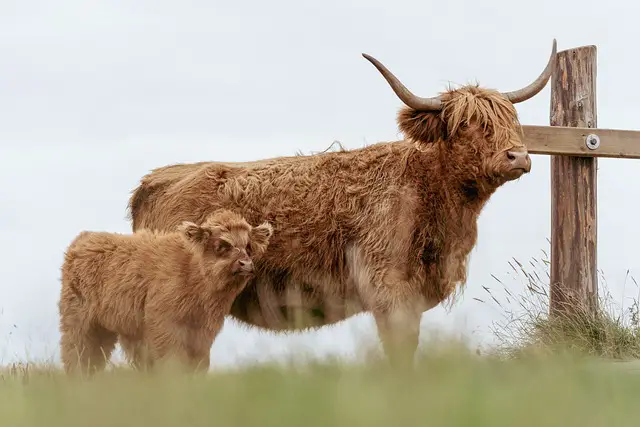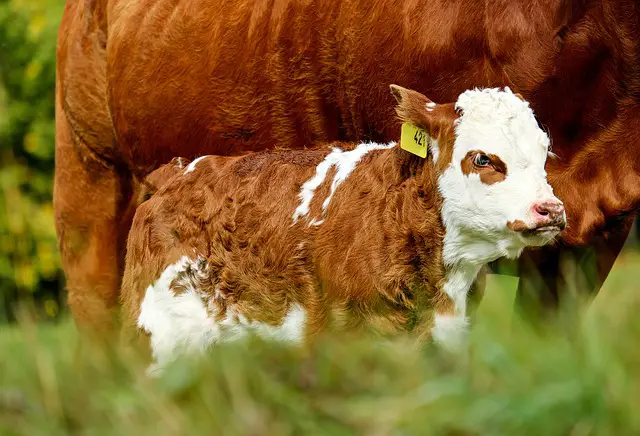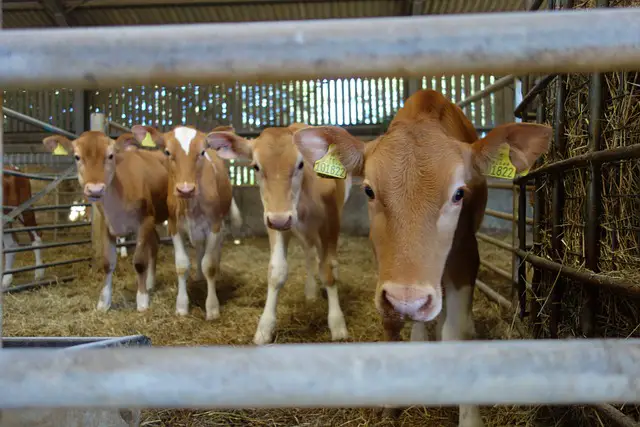For those new to cattle farming, one of the first questions is often “how much does a cow cost me?” Between purchase price, housing, feeding, medical care, and other expenses, cattle require considerable upfront and ongoing investments. Costs vary based on breed, age, location, facilities, and management practices.

This complete guide covers average cow costs, budgeting considerations, ways to save money, expected expenses by type, and factors impacting total cattle ownership costs. Understanding all aspects of choosing and caring for cows allows better planning and decision making when starting your herd.
How Much Does A Cow Cost? The Breakdown
A cow’s purchase price depends on many factors:
Breed – Beef breeds cost less than specialized dairy breeds. Crossbred beef cows are most affordable.
Age – The price generally increases with age since you’re paying for additional calves produced.
Training – Trained and gentled stock command much higher prices. Untrained cattle are least expensive.
Location – Prices fluctuate based on regional supply and demand as well as breed popularity.
Price per pound – Prices range $1-$2+ per pound based on market rates and cattle health.
Source – Buying from cattle dealers, auctions or direct farm purchases varies greatly.
How much does a cow cost can be difficult when so many factors are involved. Here’s a helpful ranch calculator from OSU that provides detailed factors to
On average, expect to pay per cow:
New calf – $300-$800+ depending on breed, pedigree, etc.
Yearling heifer – $800-$1,500 for a bred yearling.
Adult open cow – $1,000-$1,500 for an untrained mature cow.
Bred cow – $1,500-$2,500 for a bred cow with calf.
Show cow – $8,000+ for registered show-quality cattle.
Calf and feeder cattle tend to be most affordable, while bred females and trained stock have higher values.
Key Ongoing Care and Feed Costs
Annual expenses for a typical beef cow involve:
Feed – $500-$3000+ depending on feed prices and use of supplements
Veterinary – $50-$300 for vaccines, dewormers, routine vet procedures
Facilities – Barn/shelter maintenance, fencing, utilities, manure disposal
Equipment – Tractor, trailer, loader, feed bins, buckets, vet supplies
Labor – Time inputs for feeding, moving cattle, branding, emergencies
Marketing – Auction yard fees, advertising, transportation
Land – Adequate acreage of pasture and/or cropland
Realistically budget $1500-$3000+ per cow average for annual care and expenses. This does not account for profit made selling calves.

Cow Ownership Cost Estimates Over Time
Here are total cost examples over the 10+ year productive lifespan of a beef cow:
Beef heifer purchase – $2000
10 years expenses – Approximately $25,000 ($2500/year)
Total invested over 10 years – $27,000
Sale at culling age of 12 years old for $900
For one cow, be prepared to invest around $25,000-$30,000 over their lifetime until culling. Sale of calves each year helps offset costs. Expenses accrue rapidly with herd expansion.
Purchase Cost Comparison by Cattle Type
To understand cost differences based on breed and purpose, here are average price ranges:
Beef and dairy newborn calves – $100-$300 for beef breeds; $200-$500 for dairy breeds
Beef and dairy cows – $1,000-$2,000 for untrained beef cows; $2,000-$5,000 for milk-producing dairy cows
Feeder and stocker cattle – $600-$1200 for 500-800 lb. young feeder cattle
Steers and heifers – $1,000-$2,000 for young replacement heifers; $1,500-$3,000 for bred females
Mature bulls – $2000-$5000 based on pedigree, genetics, and breed
Show cattle – $8,000+ for proven winners and breeding stock
Each type serves a different role from breeding to harvesting, so purchase cost aligns with future usable value.
Ongoing Care Cost Comparison Between Beef and Dairy Cattle
Beef cattle generally cost less to care for than specialized dairy cows:
Feed – Beef cattle subsist primarily on pasture and hay. Dairy cattle require energy-dense prepared rations to fuel milk production.
Housing – Beef cattle require basic shelter options. Lactating dairy cows need elevated comfort and hygiene.
Labor – Beef cattle are more self-sufficient. Dairy cattle require hands-on milking, feeding, and health management.
veterinary – Dairy’s higher production takes more physical toll, so issues arise more frequently.
Equipment – The equipment needed for cattle handling versus twice-daily milking also differs.
Overall beef cattle offer a more economical choice as a homesteading livestock enterprise requiring less intensive management.

Ways to Reduce Cow Ownership Costs
While cattle carry notable upfront costs, there are ways to reduce overall long-term expenditures:
Raise calves yourself rather than buying adults. Put in sweat equity by bottle or bucket feeding.
Buy beef breed crossbreeds rather than high-priced pedigreed stock. Crossbred vigor improves hardiness.
Buy cattle locally rather than importing from distant states. This limits transport stress and costs.
Provide ample fall and winter hay from your own pastures rather than purchasing supplemental hay.
Use a hardy, fertile bull for breeding rather than artificial insemination.
Learn basic veterinary care like vaccines and deworming to avoid vet call fees.
Buy equipment like used tractors and cattle trailers inexpensively. Maintain and repair items yourself.
Consider lease options on land rather than purchasing acreage initially.
With savvy sourcing and attentive management, cattle ownership can produce a worthwhile return on investment over time along with satisfying homestead food production.

Popular Cows for Small Farms and Their Typical Costs
When starting a small farm, one of the biggest questions is what dairy or beef cows to raise and how much they will cost. Here are 5 of the most popular and economic cow breeds for small farms along with average price ranges:
Holstein – Holsteins are the classic black-and-white dairy cows seen dotting pastures. As the highest milk-producing dairy breed, their milk provides the base for most dairy products. However, their high production takes substantial nutrition and management. Purchase prices range $1,500-$2,500 per cow. First-calf heifers cost less at around $1,200 each.
Jersey – For their small size, Jersey cows produce milk with the highest butterfat content ideal for cream, butter and cheeses. Their lower feed requirements mean they do well on pasture. Jerseys cost $1,200-$1,800 on average. They may produce a bit less total milk than Holsteins but with much greater fat and protein concentration.
Hereford – Hereford cows are reddish beef cattle with white faces known for doing well on grass. Originally from England, their hardy nature suits them to small farms. They are calm mothers who exhibit strong protective instincts. Hereford cows range $1,000-$1,500 on average.
Angus – The most common beef breed, Angus cattle are solid black and naturally hornless. Originally from Scotland, Angus tolerate heat and varied climates well. Angus cows cost approximately $1,000-$1,500 each. Angus-cross calves offer some hybrid vigor.
Brahman – Brahman cattle originated in India so thrive in hot, humid environments with minimal care. Their loose skin and large ears radiate heat. As efficient grazers, they require less supplemental feed than other breeds. Brahman cattle usually cost $800-$1,200 per cow.
How Do I Estimate the Potential Return on Investment (ROI) for a Cow?
Breeding: For those considering breeding, estimating ROI involves understanding the market demand for calves, the growth potential of the breed, and the cost of maintaining the cow and calf until they are sold.
Milk Production: Calculating ROI for a dairy cow involves projecting milk production, factoring in market milk prices, and considering ongoing maintenance costs.
Beef Production: To estimate ROI for beef production, one needs to consider the growth rate of the cow, the market value of beef, and the overall cost of raising the cow to a marketable weight.
By addressing these expanded aspects of common questions, potential cow buyers can make more informed decisions regarding the costs and potential returns associated with cow ownership.
Cost of Calves
The price of a calf can vary based on several factors, including the breed, age, health, location, and current market conditions. Calf prices can also fluctuate seasonally and based on demand and supply dynamics. It’s important to note that prices mentioned here are approximate and can change over time. Additionally, prices may differ based on the region and specific circumstances. Here’s a general range for calf prices based on common breeds:
- Holstein Calves:
- Dairy calves from the Holstein breed, known for high milk production, can range from $50 to $400 per calf, depending on their age, health, and location.
- Jersey Calves:
- Jersey calves, valued for their milk quality, may range from $100 to $500 per calf, with prices varying based on age, health, and location.
- Angus Calves:
- Angus calves, a popular beef breed, can range from $200 to $800 per calf, depending on their age, health, and location.
- Hereford Calves:
- Hereford calves, also a prominent beef breed, may range from $250 to $800 per calf, based on age, health, and location.
- Simmental Calves:
- Simmental calves, known for beef production, can range from $300 to $1,000 per calf, depending on their age, health, and location.
- Charolais Calves:
- Charolais calves, valued in the beef industry, may range from $400 to $1,200 per calf, with prices varying based on age, health, and location.
- Limousin Calves:
- Limousin calves, a breed known for beef quality, can range from $400 to $1,200 per calf, based on their age, health, and location.
- Brahman Calves:
- Brahman calves, a popular breed in warm climates, may range from $300 to $1,000 per calf, depending on age, health, and location.
- Dairy Crossbred Calves:
- Calves from crossbred dairy cattle, which combine various dairy breeds, can range from $50 to $300 per calf, based on their age, health, and location.
Best ROI for Cattle Breeds
The best return on investment (ROI) for a breed of cow depends on various factors including your location, market demand, your goals (meat, milk, breeding), and your operational efficiency. Here’s a breakdown based on different purposes:
- Meat Production (Beef Cattle):
- Angus: Angus cattle are highly sought after for beef production due to their well-marbled, high-quality meat. They often fetch a premium price in the market.
- Hereford: Hereford cattle are known for their excellent feed efficiency, adaptability, and high-quality beef. They have a good balance of meat and marbling.
- Charolais: Charolais are known for their fast growth and excellent meat-to-bone ratio, making them an excellent choice for beef production.
- Milk Production (Dairy Cattle):
- Holstein: Holsteins are the most common dairy breed, known for their high milk production. They typically have the best ROI in terms of milk output.
- Jersey: Jerseys are smaller but efficient dairy cows known for producing milk with high butterfat content. They require less feed and space compared to larger dairy breeds.
- Ayrshire: Ayrshire cattle are known for their adaptability and efficiency in converting feed to milk. They have a good balance between milk production and feed costs.
- Dual-Purpose (Meat and Milk):
- Simmental: Simmental cattle are a popular dual-purpose breed, known for good meat quality and decent milk production.
- Red Poll: Red Polls are a dual-purpose breed known for both good meat and milk production. They are also efficient grazers.
- Local or Heritage Breeds:
- Local Adapted Breeds: In many regions, locally adapted or indigenous breeds can provide a good ROI as they are often well-suited to local climates and forage conditions, requiring less intensive management and specialized diets.
- Crossbred Cattle:
- Crossbreeds: Crossbreeding can often yield a high ROI due to hybrid vigor, resulting in more robust and productive cattle. Combining desirable traits from different breeds can optimize growth rates, disease resistance, and other attributes.
Considerations
It’s important to consider your specific circumstances, market demand in your area, climate, available resources, and your intended goals when determining the best breed for the highest ROI. Consulting with local agricultural experts and experienced cattle farmers in your region can provide valuable insights tailored to your situation. Additionally, analyzing the local market trends and demand for specific types of meat or dairy products can help guide your decision-making for optimal ROI.
How much does it cost to feed cattle per day?
The average cost per day to feed cattle can vary widely, influenced by factors such as the type of cattle (beef or dairy), their weight, age, nutritional requirements, the type of feed used, and local feed prices. On a general scale, feeding cattle can cost anywhere from $1.50 to $5.00 or more per cow per day. This cost accounts for a balanced diet of roughages (like hay and pasture), concentrates (such as grains), potential supplements, and any required health-related expenses. Seasonal variations, market conditions, and regional differences in feed availability and prices further contribute to the overall daily feeding cost. To determine a precise daily feeding cost for cattle, considering the specific needs of the cattle, consulting with a local livestock nutritionist, or agricultural extension service is advisable. They can help tailor a feeding plan that aligns with optimal nutrition and cost-efficiency for the cattle in your specific location and circumstances.

Best Cattle For Homestead
When considering the type of cow that is ideal for a homestead, several factors come into play, including available space, purpose (meat, milk, or dual-purpose), climate, and personal preferences. Here are some cow breeds often considered ideal for homesteads:
- Dexter:
- Dexters are a smaller breed, making them suitable for smaller homesteads with limited space.
- They are dual-purpose (meat and milk) and known for their gentle temperament.
- Dexters require less feed compared to larger breeds.
- Jersey:
- Jersey cows are popular for homesteads due to their manageable size and high-quality milk production.
- They are efficient grazers and produce milk with high butterfat content, ideal for making butter and cheese.
- Jerseys are known for their docile nature, making them easier to handle.
- Guernsey:
- Guernseys are a medium-sized breed, well-suited for small to medium-sized homesteads.
- They produce high-quality milk with a good butterfat content, suitable for both drinking and processing.
- Guernseys are known for their docility and adaptability to various climates.
- Milking Shorthorn:
- Milking Shorthorns are a versatile dual-purpose breed, providing both milk and beef for the homestead.
- They have a gentle disposition and are known for ease of calving.
- Milking Shorthorns are adaptable to different management systems and climates.
- Highland:
- Highland cattle are a hardy and adaptable breed, making them suitable for diverse climates and grazing conditions.
- While they are primarily beef cattle, Highland cows can provide milk for family use.
- They require minimal inputs and are known for their foraging abilities.
- Red Poll:
- Red Polls are a dual-purpose breed known for their docility and versatility.
- They produce quality milk and are efficient grazers, making them suitable for smaller homesteads.
- Red Polls are adaptable to a variety of management practices.
Final Thoughts
Choosing the right cow for a homestead involves considering factors like available space, desired output (milk, meat, or both), ease of management, climate resilience, and personal preferences. It’s crucial to research and select a breed that aligns with your specific homestead goals and resources while ensuring the welfare and sustainability of the animal. Additionally, consulting with local farmers or agricultural experts can provide valuable insights based on your particular region and circumstances.
Always budget for any necessary shelter, fencing, feed, veterinary care and other expenses when factoring total cow ownership costs. But choosing an economical breed suited your climate and facilities keeps purchase prices more affordable for start-up farms. Consider your preferences for dairy or beef production and breed temperaments as well when selecting cows to raise.
The Best Dewormer for Beef and Dairy Cattle
Safe-Guard Dewormer Suspension
The best dewormer for beef and diary cattle and goats is a must have for giardia and deworming. It is highly economical! You can find it right here on Amazon.


